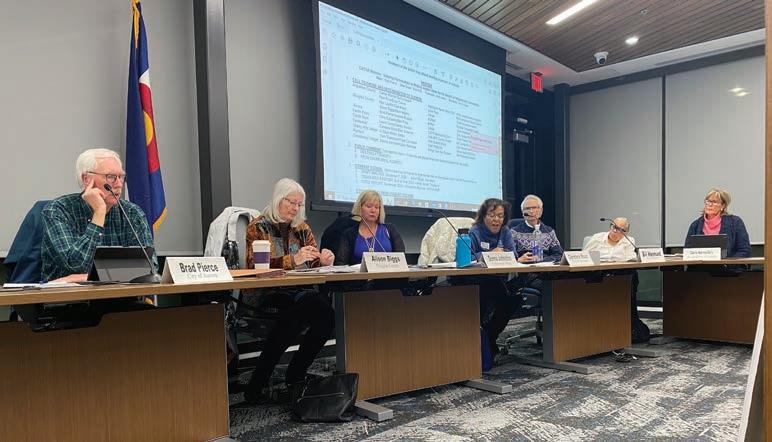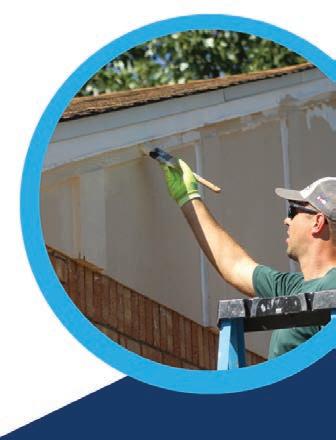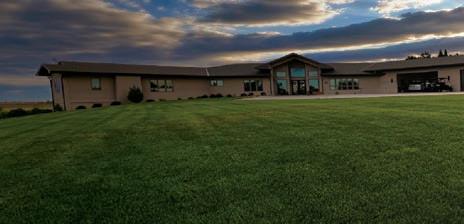
10 minute read
City sues alleged sex club
Claim focuses on location that could violate code
BY TAYLER SHAW TSHAW@COLORADOCOMMUNITYMEDIA.COM
e City of Centennial has led a lawsuit against the owners of e O ce, a business it alleges is an adult swingers’ club, for operating a sexually-oriented business where it is not permitted in the city.
A tenant of the building at 6886 S. Yosemite St., e O ce described itself as a private club, according to the city’s civil complaint, which is a legal document that initiates a lawsuit.
However, the city alleges e Ofce is actually operating a sexuallyoriented business that, for a fee, o ers people a space to engage in sexual activities, according to the court document.
e city claims the spaces in e O ce were constructed for the purpose of members engaging in
Black History In Print
Paging
FAA denies making changes post mid-air collision
While residents have reported an increase in the frequency of ights, speci cally ight school training aircraft, going over their homes, the Centennial Airport and FAA do not agree on the cause.
During the January roundtable meeting, a few people said tra c patterns had changed due to two planes colliding in midair over the Cherry Creek State Park area in May 2021, leading to more aircraft tra c above neighborhoods.
However, Michael Valencia, general manager of the FAA Denver District, disagreed that there has been a pattern change.
Valencia attended the Feb. 1 meeting in person and was joined virtually by three other FAA representatives. To help clarify what the FAA did after the mid-air collision, the administration gave a presentation.
In its assessment of the mid-air collision, the FAA “determined that we saw some drift,” Valencia said.
“When we looked at this event and how we operate as a whole here in Centennial, and other airports, we determined that we really need to tighten up our ship,” he said.
According to the presentation, air tra c controllers at Centennial Airport “received speci c refresher training on the requirement of positive control and the managing of base turns to mitigate potential con icts with aircraft landing the parallel runway and prevent the reoccurrence of another mid-air collision.”
Valencia explained that in the case of the mid-air collision, if the controller had directed one of the pilots to extend the tra c pattern, the collision likely would not have occured.
“I directed them (the controllers) that if you’re in that situation, then you’re going to take control and you’re going to prevent a collision. And you’re going to extend that downwind and manage those turns to make sure that we are preventing those,” Valencia said.
FAA representatives said this is not a change.
“We made no changes to the procedures in how we operate tra c beyond servicing the demand that is coming in. I want to make sure that I stress that,” said Justin Biassou, an FAA community engagement o cer. “ ere was no procedural change, there was nothing that was written.” A few members of the roundtable disagreed with the claim that no change was made.
“It’s a matter of semantics, again. e training that the air tra c controllers got caused a di erence in their approach to dealing with planes.
And that di erence in the approach to their dealing with planes has caused the increased noise over the communities,” said Alison Biggs, a Douglas County representative on the roundtable.
Castle Pines Councilmember Chris Eubanks, also a member of the roundtable, added, “When something is done one way and then an event happens and then it’s done di erently, I don’t know how else you can classify that as other than a change.”
FAA looks at data
According to the FAA’s analysis, the primary factor for the increase in the “visual ight rules (VFR) pattern footprint” at Centennial Airport is increased aircraft volume in the tra c pattern.
“We think the causal factor is basically the amount of aircraft that are in the pattern these days,” said Joseph Bert, manager of the FAA’s operations support group.
According to the presentation, as more aircraft are added to the tra c pattern, the pattern elongates due to saturation and having to maintain a safe amount of distance between the aircraft.
When it comes to tracking ight activity, there are two di erent types of counting — ight tracks versus operations.

For example, if an aircraft does six touch-and-go landings, which is when a plane lands and takes o again without coming to a full stop, it will count as one ight track. However, that same scenario would count as 12 operations, because each touch-and-go landing will count as an arrival and departure, Bert explained.
e FAA said Centennial Airport’s ight tracks were up 23.7% from 2019 to 2022. Speci cally over Greenwood Village, the number of ight tracks was up 74.9% from 2019 to 2022, according to the FAA’s data.
e FAA noted there is not a direct correlation between the reported overall track increase and the track increase over Greenwood Village.
“ is is due to the daisy chain e ect. Once a tipping point is reached where the pattern elongates to Greenwood Village, it is not just that single extra aircraft in the pattern that will over y the area. Every aircraft in the pattern will, in turn, follow that same elongated ground track,” according to the presentation.
“ e substantial growth at APA (Centennial Airport) has resulted in the signi cant increase of the number of VFR (tracks) over Greenwood Village,” Bert said. “I’m not saying it’s solely the amount of aircraft. ere are other situations and examples that would cause this, but the majority of it, we think, is the amount of aircraft in the pattern itself.”
Airport disagrees with FAA’s conclusion
In a Feb. 6 interview with Colorado Community Media, Centen- nial Airport Executive Director and CEO Mike Fronapfel said the airport believes the change that caused more aircraft to y over neighborhoods happened well before eight months ago. e airport thinks that after the mid-air collision occurred, the FAA local control tower changed the way it managed the aircraft in the pattern, resulting in the pattern getting extended more frequently over the community, he said.
“We stand by that, still. We disagree with the FAA’s analysis, or initial analysis, of that,” Fronapfel said.
He thinks the FAA is concerned about changing procedures or changing the tra c pattern because doing so could trigger an environmental process requirement.
“And so, by saying they changed the way they manage the aircraft, not speci cally the pattern, I think that they’re trying to get away from getting caught for not doing an environmental (process), essentially,” Fronapfel said. “I would agree with them, maybe speci cally, they didn’t change the pattern, but … when they changed the managing of the tra c, that resulted in the pattern changing.
“And their contention is that it wasn’t them, it was the number of aircraft that are in the pattern at any given time,” Fronapfel said. “Well, the numbers we have, that were provided by the FAA’s own tower personnel, prove that wrong.”
During the Feb. 1 meeting, Fronapfel said the airport’s ight operations in 2022 were less than in 2019.
“Looking at our overall operations for 2019, we had 355,784 operations, and that’s based on (the) tower counts. In 2022, that dropped to 302,660,” Fronapfel said. “If we look at just the local tra c — which, in our view … the majority of the local trafc is pattern tra c — in 2019, it was 167,818. And then in 2022, it dropped down to 132,026.”
Local tra c refers to when the aircraft stays within the airspace during their ight, he explained, and most of the local tra c is training aircrafts.
“We do agree that there’s more aircraft over the community now than there used to be. Where we disagree is about why that is occurring,” Fronapfel said. “We disagree that there are more aircraft utilizing the pattern now than there was in 2019. We actually think it’s just the opposite.”
Responding to Fronapfel, Bert noted the di erence between ight tracks and ight operations.
“When you say you dispute our data, you’re really comparing apples and oranges,” Bert said. “What we’re trying to tell you is our data is showing that it is because we have more aircraft in the pattern overall, period.” Fronapfel said there are a lot of di erent ways the data can be split and the airport will be doing more analysis.
“I’m hopeful that we’re gonna be able to come back to the next meeting and have a uni ed analysis of what’s occurred,” he said.
Regarding the timeline of when a change occurred, Fronapfel said he can’t explain why some community members noticed a change eight months ago.
“I’m hoping to be able to explain more of that once we dive into the data a little bit more,” he said. “ ere’s all kinds of variables that could be at play.”
The role of flight schools

Part of the equation in addressing resident concerns is the ight schools, Fronapfel said.
“You need both the FAA and the pilots to, you know, concur and agree and make an e ort to keep that pattern south of Arapahoe Road,” he said. “And from what I’ve heard … they want to be good neighbors as much as they can.” ere are four major ight schools — Flights Inc, ATP Flight School, Independence Aviation and Aspen Flying Club — and a few di erent ight clubs that utilize Centennial Airport, Fronapfel said.
“What we’ve heard from the ight schools is there’s a really strong demand for pilots right now,” he said. “So, the training activity has increased.” e airport recently had a meeting with some of the ight schools, which Fronapfel said was productive. Part of the conversation was how training aircraft y in the tra c pattern when they are not being directed by the FAA’s control tower. ere are some scenarios where the pilots are given speci c instructions by the FAA to extend the tra c pattern, Fronapfel said. However, there are other times where it is the pilot and instructor who determine whether to extend the pattern.
“When they have the option and when they have control over whether they extend or not, we want them to follow the noise abatement guidelines whenever possible. And so, they were receptive to that,” Fronapfel said. “It’s not the last meeting we’ll have with them. I think we need to continue that conversation.”
Anonymous letter from flight instructor Fronapfel shared with Colorado Community Media a copy of an anonymous open letter from someone who claims to be a ight instructor at Centennial Airport.
“I write this anonymously because it is clear the public has picked on ight schools and pilots as the one to blame for the recent noise issues since the Key Lime mid-air and now the issues with leaded fuel,” the letter states. “I would like to answer some of the public’s questions from my point of view. You will nd that we agree with you on virtually all counts.” ey said the ight school they work with will commit to voluntary additions to the current voluntary noise abatement procedure. ese additions include: restricting northbound touch-and-go landings to occur between 6 a.m. and 7 p.m.; staying south of Arapahoe Road after departure when the control tower and safety of ight allows; and working with the other ight schools towards reforming the practice areas to accommodate the new and existing residential developments.
In the letter, the anonymous source said leaded fuel needs to go away entirely, and they rarely think there is a need for any training aircraft to y over the communities north of Arapahoe Road.
“Virtually all tra c being routed that direction is doing so at the command of the tower, who is operating under the direction of the FAA. We don’t like ying this way … as it puts us over residential areas and increases our time in the pattern,” the letter states.

“Ultimately the responsibility of returning pattern operations to its previous standard rests solely with the FAA. e failures of one private pilot does not represent the capabilities of the hundreds of commercial pilots that operate at this eld every day,” the letter states, referring to the mid-air collision.
“ e non-standard tra c environment has increased both pilot and controller work-load, reducing safety for us in the air, and the people below us.”
Can a capacity limit be placed on the tra c pattern?
One idea that was raised during the roundtable meeting was limiting the amount of aircraft permitted in the tra c pattern at a time.
A few representatives of the roundtable inquired whether the FAA would restrict the number of aircraft in the pattern.
“We have strict constraints that are given to us by Congress, and our mandate is to ensure safe operations within the pattern in the local area,” Biassou said. “We know that the airport receives AIP (Airport Improvement Program) grants funding from the federal government. And so to
SEE AIRPORT, P22 by appointment to people in the area. Eventually, a move to a commercial space felt right.







In addition to shelves and shelves of plants, Austin lls her boutique with touches of home. A plush couch. A clawfoot bathtub. A white wicker chair. It helps her customers think about how to style their own houses with plants.


“It kind of gives people an idea of ‘OK, I can see this in my living room,’” she said.
While Austin enjoys the plant world, her rst love is all things morbid. As a grade schooler, she was a fan of the TV show “Forensic Files.” She was nicknamed Wednesday, a reference to the death-obsessed daughter from the ctional Addams Family. At Metropolitan State University, she earned a bachelor’s degree in forensic anthropology and criminology and landed an internship as a death investigator with the medical examiner’s o ce in Denver, she said. But ultimately she stepped back from forensic work.
“I’ve kind of come full circle. Now I keep plants alive,” said Austin of her shift from working with the dead to caring for living, leafy things.
While being her own boss means she can’t count on someone else for health insurance, a 401(k) program or overtime pay, Austin appreciates the exibility that comes with working for herself. It’s a big world with lots to see and do, Austin said, and right now she’s enjoying the challenges of small business ownership.
“I have my moments where I wonder what the hell was I thinking, but every entrepreneur does,” Austin said. “If not, I don’t know if you’re doing it right.”
For example, now that it’s in a retail space, Mrs. Fancy Plants’ overhead is higher. It was a bit of a shock the rst time the business hit a seasonal slump but its rent and utilities didn’t abate, Austin said. She supplements retail sales with classes on building terrariums, arranging owers and caring for houseplants. She also makes the space available to photographers for photoshoots.


“You pivot and you improvise,” Austin said. “It’s part of being an entrepreneur. It’s a marathon, not a sprint.”

Key benefits include:













